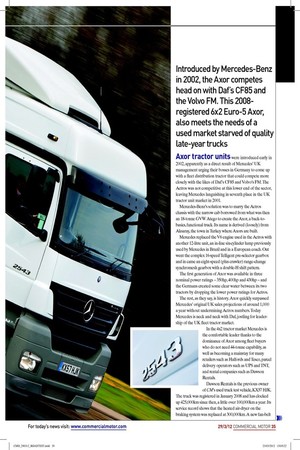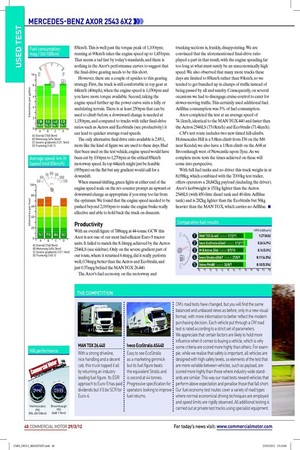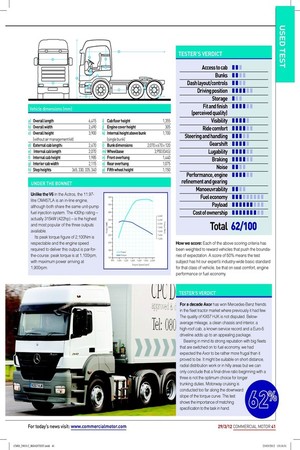Sensible used buy
Page 27

Page 28

Page 29

Page 32

Page 33

Page 30

Page 34

If you've noticed an error in this article please click here to report it so we can fix it.
MERCEDES-BENZ
AXOR 2543 6x2 We put the Axor through its paces
Introduced by Mercedes-Benz in 2002, the Axor competes head on with Daf’s CF85 and the Volvo FM. This 2008registered 6x2 Euro-5 Axor, also meets the needs of a used market starved of quality late-year trucks
Axor tractor units were introduced early in
2002, apparently as a direct result of Mercedes’ UK management urging their bosses in Germany to come up with a leet distribution tractor that could compete more closely with the likes of Daf’s CF85 and Volvo’s FM. The Actros was not competitive at this lower end of the sector, leaving Mercedes languishing in seventh place in the UK tractor unit market in 2001.
Mercedes-Benz’s solution was to marry the Actros chassis with the narrow cab borrowed from what was then an 18-tonne GVW Atego to create the Axor, a back-tobasics, functional truck. Its name is derived (loosely) from Aksaray, the town in Turkey where Axors are built.
Mercedes replaced the V6 engine used in the Actros with another 12-litre unit, an in-line six-cylinder lump previously used by Mercedes in Brazil and in a European coach. Out went the complex 16-speed Telligent pre-selector gearbox and in came an eight-speed (plus crawler) range-change synchromesh gearbox with a double-H shift pattern.
The irst generation of Axor was available in three nominal power ratings – 350hp, 400hp and 430hp – and the Germans created some clear water between its two tractors by dropping the lower power ratings for Actros.
The rest, as they say, is history. Axor quickly surpassed Mercedes’ original UK sales projections of around 1,000 a year without undermining Actros numbers. Today Mercedes is neck and neck with Daf, jostling for leadership of the UK leet tractor market.
In the 4x2 tractor market Mercedes is the comfortable leader thanks to the dominance of Axor among leet buyers who do not need 44-tonne capability, as well as becoming a mainstay for many retailers such as Halfords and Tesco, parcel delivery operators such as UPS and TNT, and rental companies such as Dawson Rentals.
Dawson Rentals is the previous owner
of CM’s used truck test vehicle, KX57 HJK. The truck was registered in January 2008 and has clocked up 425,000km since then, a little over 100,000km a year. Its service record shows that the heated air-dryer on the braking system was replaced at 300,000km. A new fan-belt
tensioner and radiator has been itted, as well as a new clutch at 408,000km. This last item is surprising: vastly superior clutch life is advertised as one of the big pluses for automated transmission of the type itted to the test vehicle.
An uncomplicated vehicle like the Axor should make a particularly sensible used vehicle, although its small cab will not please future owners looking for something bigger and plusher, as it will have an effect on its residual value. However, late-year Euro-4 and Euro-5 trucks are thin on the ground, which pushes prices up. On balance, CAP reckons this four-year-old Axor should fetch £29,250. In three years time when the truck will be seven years old Cap Monitor, which predicts future truck prices, says the Axor will be valued at £10,200. Mercedes-Benz UK values this example rather more highly than CAP, asking £31,995 (plus VAT).
Mercedes-Benz offers a full repair and maintenance package supported by the dealer network, or can supply a six months’ warranty that can be extended to 36 months.
Recent road tests of several other Euro-5 6x2 tractors provide compelling comparisons with this Axor (see productivity). These are the Mercedes Actros 2546LS (CM 8 July 2010) itted with the 12-litre V6, and the MAN TGX 26.440 with its 12.4-litre engine (CM 8 December 2011). Both have similar-sized engines but a little more power. We also include Iveco’s 460hp EcoStralis (CM 15 December 2011), boasting more power than the Axor but from an engine of just 10.3 litres.
Technical profile
Unlike the V6 in the Actros, the 11.97-litre OM457LA is an in-line engine, although both share the same unitpump fuel injection system, rather than a common-rail set-up. The 430hp rating in our test vehicle – actually 315kW (422hp) – is the highest and most popular of the three outputs available. Although some way short of the 10hp/tonne yardstick, its peak torque igure of 2,100Nm is respectable and the engine speed required to deliver this output is par for the course: peak torque is at 1,100rpm, with maximum power arriving at 1,900rpm. In fact, there is no point exceeding 1,600rpm because by then you have 99% of the available power and the torque slips away fast once you are beyond 1,400rpm.
The test vehicle is itted with a G211 Powershift 12-speed gearbox. Mercedes came late to the automated gearbox game, persisting far too long, in our opinion, with the semi-auto, electro-pneumatic 16-speed Telligent gearbox and then its clunky (but fully-automated) Autotrans derivation. ZF’s AS Tronic and Volvo I-Shift had been around for years before Mercedes introduced its equivalent two-pedal automated manual box, Powershift, in 2006. It was originally a £1,600 option in Axor but is now standard, with the eight-speed manual relegated to the substitute’s bench.
The 12-speed Powershift is similar to AS Tronic and I-Shift, having three main gears, multiplied into six ratios by range-change gears on the output end of the gearbox, while a splitter on the input end halves the increments between steps to produce 12 ratios. The three main gears are constant-mesh, with gear speed matching achieved by braking the layshaft. This is faster than synchromesh, making shifts speedier and allowing big jumps between gears, so fewer shifts are needed. Top gear is 1:1.
With 12 rather than eight ratios, but fewer gear-shifts thanks to smart electronic programming, auto Axors should be more fuel eficient than manual versions.
One could grumble that the 6x2 version of a tractor unit aimed fairly and squarely at the distribution market should have a twin-steer coniguration so that it can negotiate all those roundabouts. The upside of the Axor’s non-steering mid-lift axle is that it is cheaper, simpler and lighter: steering linkages typically add around 100kg to a mid-lift axle. If weight is really critical, you can also have a 6x2 Axor with a lightweight mid-lift axle with 17.5-inch wheels, plated for 4.3 tonnes. This is 200kg lighter than the standard 6x2 model.
Axor’s disc-brake system includes ABS (anti-lock) and there is a two-stage engine-brake. The irst stage is a constant throttle brake, where the cylinder compression is vented to the exhaust manifold rather than powering the down-stroke. The second stage is a butterly valve on the exhaust.
The test truck has the high-roof, long-distance cab, which is approximately 100kg heavier and 400mm taller than the low-roof sleeper cab.
On the road
The non-steering nature of the middle axle is immediately apparent. On roundabouts, and even on A-roads, there are moments when it feels as if the truck is disinclined to round bends. The level of scrub this creates reduces momentum, and feeding in more power to get back up to speed must surely do no favours for the fuel consumption. Lifting the axle addresses this problem, but there are limited opportunities to do this because the system is set up to drop the axle when the load on the drive-axle reaches nine tonnes and road speed passes 30km/h. With our test vehicle at 44-tonne GCW it was only possible to lift the axle during low-speed manoeuvring.
In Powershift Mercedes-Benz has an automated transmission that is easily the match of its longer-established competitors. Gentle use of the accelerator pedal prompts upward gear shifts at approximately 1,350rpm, before the torque begins to head southwards more sharply at about 1,400rpm. For more heavier-footed drivers the alternative is to use manual override to change up before engine speed rises too far.
Attempting to wring the very best fuel igure from the Axor, CM usually switched to manual after ninth gear was engaged in order to ind the optimum point to engage top gear. The ‘paddle and nudge’ manual gear change controls on the fold-down left-hand armrest are a joy to use, even though every other manufacturer prefers a stalk on the steering column: even Mercedes has opted for a stalk on the new Actros.
If you buy this truck then you might want to consider changing the inal drive ratio to something taller. There was a time when 3.08:1 was an industry benchmark, but with today’s engines it veers too much towards power and not fully utilising torque.
The standard inal-drive ratio, also itted to this test vehicle, is 3.08:1. When mated to the 295/80 R22.5 tyres this gearing means the engine is turning at 1,370rpm when the truck is travelling at CM’s motorway cruising speed of
85km/h. This is well past the torque peak of 1,100rpm; running at 90km/h takes the engine speed up to 1,451rpm. That seems a tad fast by today’s standards, and there is nothing in the Axor’s performance curves to suggest that the inal-drive gearing needs to be this short.
However, there are a couple of upsides to this gearing strategy. First, the truck is still comfortable in top gear at 64km/h (40mph), when the engine speed is 1,030rpm and you have more torque available. Second, taking the engine speed further up the power curve suits a hilly or undulating terrain. There is at least 250rpm that can be used to climb before a downward change is needed at 1,150rpm, and compared to trucks with taller inal-drive ratios such as Actros and EcoStralis (see productivity) it can lead to quicker average road speeds.
The only alternative inal drive ratio available is 2.85:1, more like the kind of igure we are used to these days. Had that been used on the test vehicle, engine speed would have been cut by 100rpm to 1,270rpm at the critical 85km/h motorway speed. In top 64km/h might just be feasible (955rpm) on the lat but any gradient would call for a downshift.
When manual shifting, green lights at either end of the engine speed scale on the rev counter prompt an upward or downward change as appropriate if you stray too far from the optimum. We found that the engine speed needed to be pushed beyond 2,000rpm to make the engine brake really effective and able to hold back the truck on descents.
Productivity
With an overall igure of 7.88mpg at 44-tonne GCW this Axor is not one of our most fuel-eficient Euro-5 tractor units. It failed to match the 8.14mpg achieved by the Actros 2546LS (see sidebar). Only on the severe gradient part of our route, where it returned 6.4mpg, did it really perform well, 0.74mpg better than the Actros and EcoStralis, and just 0.37mpg behind the MAN TGX 26.440.
The Axor’s fuel economy on the motorway and trunking sections is, frankly, disappointing. We are convinced that the aforementioned inal-drive ratio played a part in that result, with the engine spending far too long at what must surely be an uneconomically high speed. We also observed that many more trucks these days are limited to 85km/h rather than 90km/h, so we tended to get bunched up in clumps of trafic instead of being passed by all and sundry. Consequently, on several occasions we had to disengage cruise-control to cater for slower-moving trafic. This certainly used additional fuel. AdBlue consumption was 5% of fuel consumption.
Axor completed the test at an average speed of 74.1km/h, identical to the MAN TGX.440 and faster than the Actros 2546LS (73.0km/h) and EcoStralis (71.4km/h).
CM’s test route includes two new timed hill-climbs. Holmescales Hill is a 5.8km climb from J36 on the M6 near Kendal; we also have a 1.9km climb on the A68 at Broomhaugh west of Newcastle-upon-Tyne. As we complete more tests the times achieved on these will come into perspective.
With full fuel tanks and no driver this truck weighs in at 8,058kg, which combined with the 7,000kg test trailer, offers operators a 28,842kg payload (including the driver). Axor’s kerbweight is 151kg lighter than the Actros 2546LS (with 450-litre diesel tank and 40-litre AdBlue tank) and is 282kg lighter than the EcoStralis but 56kg heavier than the MAN TGX, which carries no AdBlue. ■ THE COMPETITION MAN TGX 26.440 With a strong driveline, nice handling and a decent cab, this truck topped it all by returning an industry leading fuel figure. Its EGR approach to Euro-5 has paid dividends but it’ll be SCR for Euro-6. Iveco EcoStralis AS440 Easy to see EcoStralis as a marketing gimmick but its fuel figure beats the equivalent Stralis and is second at 44 tonnes. Progressive specification for operators looking to improve fuel returns.
CM’s road tests have changed, but you will find the same balanced and unbiased views as before, only in a new visual format, with more information to better reflect the modern purchasing decision. Each vehicle put through a CM road test is rated according to a strict set of parameters. We appreciate that certain factors are likely to hold more influence when it comes to buying a vehicle, which is why some criteria are scored more highly than others. For example, while we realise that safety is important, all vehicles are designed with high safety levels, so elements of the test that are more variable between vehicles, such as payload, are scored more highly than those where industry-wide standards are similar. This way our road tests reward vehicles that perform above expectation and penalise those that fall short. Our fuel economy test routes cover a variety of road types where normal economical driving techniques are employed and speed limits are rigidly observed. All additional testing is carried out at private test tracks using specialist equipment.
CAB COMFORT
Buying a truck that belonged to a rental company usually ensures the interior will be spotless but basic. Cabs are cleaned on a regular basis and we found no damage, scuff marks, cigarette holes or coffee stains.
The high-roof sleeper cab offers 1.99m of internal height provided you stand in the footwell: there is 1.69m above the engine cover. Interior width is 260mm (10.5 inches) less than the Actros.
Standard specification includes an electric roof hatch, electric windows for both doors, an external storage compartment on the offside, an air-suspended driver’s seat, a single passenger seat, storage pockets on the rear wall, and storage above the windscreen.
Worthwhile options on used Axors include remote-control locking, a second bunk, air-conditioning and driver’s airbag. The main storage includes pockets built into the doors and more pockets above the doors. TESTER’S VERDICT For a decade Axor has won Mercedes-Benz friends in the fleet tractor market where previously it had few. The quality of KX57 HJK is not disputed. Belowaverage mileage, a clean chassis and interior, a high-roof cab, a known service record and a Euro-5 driveline adds up to an appealing package.
Bearing in mind its strong reputation with big fleets that are switched on to fuel economy, we had expected the Axor to be rather more frugal than it proved to be. It might be suitable on short distance, radial distribution work or in hilly areas but we can only conclude that a final-drive ratio beginning with a three is not the optimum choice for longer trunking duties. Motorway cruising is conducted too far along the downward slope of the torque curve. This test shows the importance of matching specification to the task in hand.
Total 62/100












































